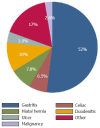Performance of American Society for Gastrointestinal Endoscopy guidelines for dyspepsia in Saudi population: prospective observational study
- PMID: 25605988
- PMCID: PMC4296026
- DOI: 10.3748/wjg.v21.i2.637
Performance of American Society for Gastrointestinal Endoscopy guidelines for dyspepsia in Saudi population: prospective observational study
Abstract
Aim: To evaluate adherence of primary care physicians (PCPs) to international guidelines when referring patients for upper-gastrointestinal endoscopy (UGE), evaluate the importance of alarm symptoms and the performance of the American Society for Gastrointestinal Endoscopy (ASGE) guidelines in a Saudi population.
Methods: A prospective, observational cross-sectional study on dyspeptic patients undergoing UGE who were referred by PCPs over a 4 mo period. Referrals were classified as appropriate or inappropriate according to adherence to ASGE guidelines.
Results: Total of 221 dyspeptic patients was enrolled; 161 patients met our inclusion criteria. Mean age was 40.3 years (SD ± 18.1). Females comprised 70.1%. Alarm symptoms included low hemoglobin level (39%), weight loss (18%), vomiting (16%), loss of appetite (16%), difficulty swallowing (3%), and gastrointestinal bleeding (3%). Abnormal endoscopy findings included gastritis (52%), duodenitis (10%), hiatus hernia (7.8%), features suggestive of celiac disease (6.5%), ulcers (3.9%), malignancy (2.6%) and gastroesophageal reflux disease (GERD: 17%). Among patients who underwent UGE, 63% met ASGE guidelines, and 50% had abnormal endoscopic findings. Endoscopy was not indicated in remaining 37% of patients. Among the latter group, endoscopy was normal in 54% of patients. There was no difference in proportion of abnormal endoscopic findings between two groups (P = 0.639).
Conclusion: Dyspeptic patients had a low prevalence of important endoscopic lesions, and none of the alarm symptoms could significantly predict abnormal endoscopic findings.
Keywords: American Society for Gastrointestinal Endoscopy guideline; Dyspepsia; Primary care physician; Saudi population; Upper gastrointestinal endoscopy.
Figures
References
-
- National Institute for Health and Clinical Excellence. Dyspepsia: Management of dyspepsia in adults in primary care. Available from: http://www.nice.org.uk/CG017NICEguideline.
-
- Talley NJ, Vakil NB, Moayyedi P. American gastroenterological association technical review on the evaluation of dyspepsia. Gastroenterology. 2005;129:1756–1780. - PubMed
-
- Heading RC. Prevalence of upper gastrointestinal symptoms in the general population: a systematic review. Scand J Gastroenterol Suppl. 1999;231:3–8. - PubMed
-
- El-Serag HB, Talley NJ. Systemic review: the prevalence and clinical course of functional dyspepsia. Aliment Pharmacol Ther. 2004;19:643–654. - PubMed
Publication types
MeSH terms
LinkOut - more resources
Full Text Sources
Other Literature Sources
Medical
Miscellaneous


